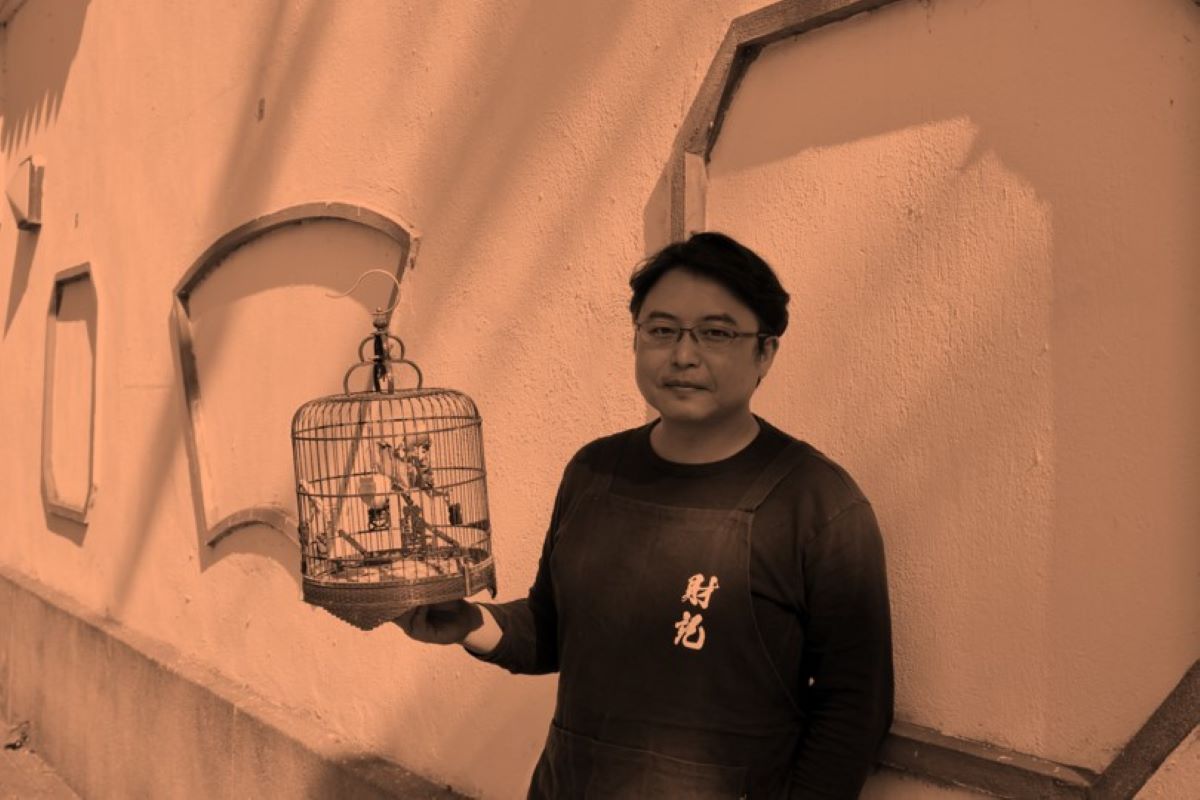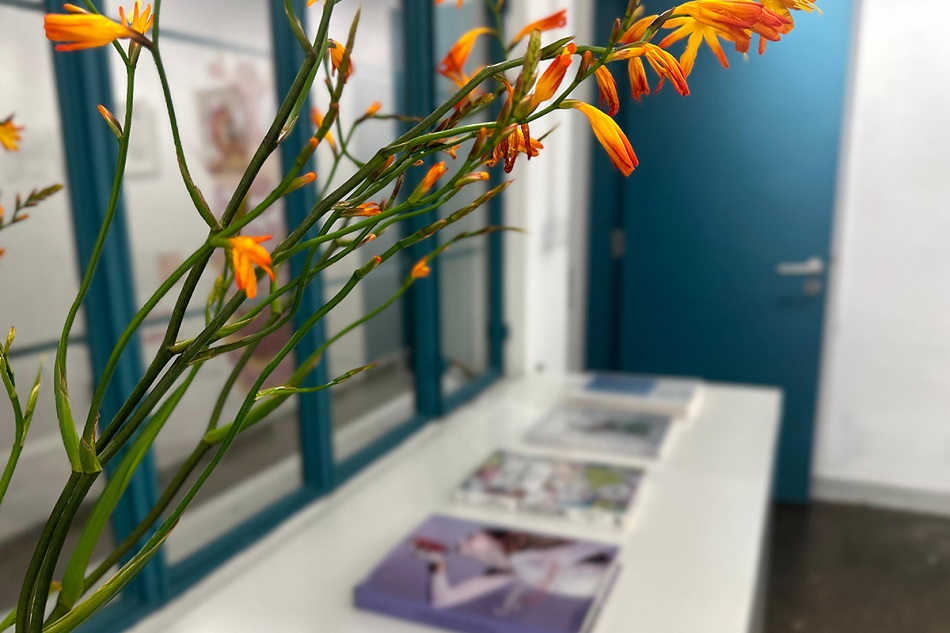Design Feature #57
When a modern designer meets traditional birdcage crafts
Dylan Kwok

Text: TL ling
Translated by: Joel Wong
Image: TL Ling
Furniture designer Dylan Kwok goes to Bird Street (Bird Garden on Yuen Po Street, Mong Kok) every week to help out at the shop owned by birdcage craftsman Chan Lok Choi (Choi Suk, which means Uncle Choi in Cantonese). Dylan got his apprenticeship through a formal "tea ceremony" to serve Choi Suk as the Master. "By strict tradition, I held a feast to be official!" Dylan studied in Canada and Finland. After returning to Hong Kong, he became increasingly interested in bamboo and handmade bamboo birdcages. And because of that, another world has opened up for him to explore.

Designer and author of the book Open Birdcages, Dylan Kwok.
"I studied small-scale architecture and furniture design abroad. Birdcages are mini buildings for birds and furniture for people." Being able to design has nothing to do with one's craftsmanship and learning to craft birdcages allowed Dylan to advance further from a designer's perspective. He refers to furniture design as a reflection of lifestyle, namely Nordic style, industrial style, etc. "What kind of lifestyle is ours? The birdcage allows me to grasp an entry to Hong Kong's culture and define Eastern lifestyle and aesthetics."
Constructing a birdcage involves a sturdy foundation
Times have changed, and birdcages in China and Southeast Asia have taken various forms and styles. The image of birdcage in Hong Kong people's minds was still nostalgic, as Dylan said, those brown-reddish ones with a dome top. "This kind of Guangdong-style birdcage is a powerful cultural icon. Even if you have never kept a bird as a pet, you must have seen one of those in movies, like Chow Yun-fat's movies in the past. In recent years, the pop music duo MC $oHo & KidNey's "See Ya" (《係咁先啦》) The MV also contains a scene of carrying a birdcage."

Birdcage craftsman Chan Lok Choi still runs his shop at Bird Street.
Even Dylan treated birdcages as cultural icons, but not until 2019 when an art gallery held an exhibition and invited him to design furniture inspired by traditional crafts, did he meet Choi Suk, who makes and repairs birdcages. "Crafting birdcage by hand was so much fun, and I was immediately hooked. I know nothing about crafting birdcages and didn't even know how to use tools or drill a hole! I discovered that each part of the birdcage has a name for it. For example, the part above the cage body is called the cage frame, and there is also a core inside that frame. So interesting." From that year onward, Dylan became a frequent visitor to Bird Street and Choi Suk's shop every week to learn how to craft, and in 2022, he officially became an apprentice of Choi Suk.

As the apprentice of Hong Kong's birdcage master craftsman Cheuk Hong, Choi Suk made this cage to pay tribute to his master's work.
In his eighties now, Choi Suk still operates his shop daily, energetic and humble. Dylan would repair those broken cages for him. "Choi Suk started this craft at the age of 13. I doubt I could learn all his skills after all! I can assemble a birdcage from parts, but I didn't know how to build one." Dylan hopes he can build a birdcage from scratch one day. More importantly, "I want to study and learn more about bamboo through birdcage-crafting."

Once Dylan arrives at the shop, he puts on the apron and gets to work.
Enhancing the craftmanship by means of design
Dylan is such a walking encyclopedia. While discussing the making of birdcages with him, he would do so step by step and embed lots of jargon within context. For example, he knows how to thin out the bamboo using a metal tool full of small round holes, pull the bamboo through them, and cut them into cylindrical branches to construct the frame. Last year, Dylan published a book called Open Birdcages about Hong Kong's bird culture and birdcage crafts. It is written in fine details and well-illustrated, the section about structure of birdcages alone takes up more than 20 pages of the book.

Choi Suk serves as the consultant of Open Birdcages, Dylan refers to him as the heart and soul of the book.

Detailed breakdown of parts of a birdcage.
Dylan documented what he learned from Choi Suk in the past few years and wrote in Open Birdcages. He also asked friends to do design drawings of birdcages, as well as architectural sketches of stores on Bird Street. "My background helps me to use images and text to document these contents. Even Choi Suk has deep knowledge about birdcages, but no one is willing to document the details and pass them on to future generations; such craft of birdcage will vanish, let alone someone would be interested in entering the industry." Dylan admits he was not young when he first encountered the art. "I was worried that I would not be able to learn it well! But on the contrary, as a designer, I can actually help to promote the birdcage craft." One is a drawing from Open Birdcages and the other is Dylan's tools for making birdcages. "Craftsmen often make their own tools, and the paring knife that Choi Suk uses to flatten bamboo strips was made by an old friend of a long time ago". Dylan 3D-printed an identical paring knife and went to Japan to ask a knifesmith to make a knife based on it. "Without this knife, it would be difficult to start making birdcages, and as a designer, I know how to turn it into a product," he says.

Open Birdcages is about Bird Street and contains illustrations of the shops around the area.

From left:A 3D printed version of Choi Suk’s bamboo sharpener, the other two are replicas made by a Japanese knifesmith.
Birdcage Designs Catering to User's Requirements
Dylan wrote in Open Birdcages that he remembered that in the 1980s, he would see birdcages made of bamboo in teahouses, on buses, streets, and even the arcades of public housing estates. But after the 1997 and 2003 bird flu spree, as he mentioned in the book, "The quality of life has improved drastically in Hong Kong, more people move into private housings, and the choice of pets also broadened. These factors have led to the gradual vanishing of the bird culture. " Dylan keeps birds because he learned the craft of birdcages. He noted the language of product design shifting towards the user side. "Now I have a Japanese White-eye, an oriental magpie-robin, and two canaries. How they fly through the cage door is entirely different. If you don't understand the behavior of birds, you can't build them the proper cages.
Cages are often treated as the homes for birds. But Dylan would let the birds out of their cages and let them fly freely inside the room. "So I would say cages are, in fact, the rooms for birds." He feels the public has some misconceptions about birdcages, "For example, a bird in a cage means no freedom. Of course, as a designer, I have my views, but many objects should not represent certain connotations. And cages carry too many negative connotations in our culture. "Birdcages are in a “cage” form because of their design and functionalities. "Birds also need to maneuver and hold onto something inside the cage, like the climbing frame at the playground for kids to climb and play." Misconception often stems from unfamiliarity. Dylan teaches design at University, he wants to attract more young people to learn about birdcage craftsmanship. He brings his students to Bird Street (Yuen Po Street Bird Garden at Mongkok). "I hope the younger generation will get familiar with the community there, understand the culture of keeping birds, and even have the opportunity to renew this culture."


